Suppose your television has died. Would you then immediately opt for the latest 65-inch Oled TV with Soundbar and Google Assistant? Probably not. Before you decide to buy, you will have gone through several stages. From researching information and reading reviews to comparing prices.
Therefore, to help the customer in the best possible way, you create customised content for potential customers in an inbound marketing strategy. You match the information provided with the stage of the buyer journey they are in. We distinguish three stages:
- the Awareness stage
- the Consideration stage
- the Decision stage
This three-stage process is visualised as a funnel: a funnel that someone passes through during their buyer journey. The wide top of the funnel is the Awareness stage, the middle part represents the Consideration stage, and at the bottom, you have the Decision stage.
Awareness
During the awareness stage, the potential customer experiences a problem. They are faced with a challenge that they cannot clearly define. Therefore, they go on a research journey to formulate the problem clearly for themselves in this stage. This means that finding information is key in the awareness stage. Which content types are relevant for a prospect?
Blogs
You can use blogs to inform potential customers in an accessible, surprising way. In the Awareness stage, you write blogs in which you incorporate tips, make suggestions and give basic information about a subject. Examples:
- Do's and don'ts when creating a Customer Journey Map.
-
What is involved in a Viral marketing campaign?
E-books
These guides are a great way to showcase your expertise. Because the content is free, you do not put any pressure on your potential customer. You often ask for contact details, but there is no obligation to receive this free content. You can easily compile an e-book by combining popular blogs. Examples:
- Get off to a good start with e-mail marketing.
- The ultimate guide to social media.
Infographics
A picture says more than a thousand words. Infographics are thus suitable for making boring or complicated messages clear in a catchy way.
Examples:
-
The right words for call-to-action buttons.
-
Which image formats should I use for social media platforms?
During the Awareness stage, you assist the customer. It is all about showcasing expertise and not so much about offering concrete products or services. You can make a brief reference to your company in a CTA at the bottom of a message. Remember: the potential customer is orientating himself. Do not force yourself on them; that will only cause irritation.
Consideration
Your potential customer has made a final decision on how to solve his problem. Options are compared, so the content in this stage focuses on explaining products and comparing services. Your content anticipates relevant industry developments, and by answering help questions, you again demonstrate your expertise. You work towards Thought Leadership. You are the authority within your sector. You can offer content in the form of webinars, white papers, cases and spreadsheets. What other forms of content are appropriate for this phase?
Checklist
Checklists help leads to plan and organise their tasks. They come in all shapes and sizes: from simple to-do lists to comprehensive instructional guides. Examples:
- Checklist 'Optimising a Landing Page for SEO'
- Checklist 'Inbound campaign'
Calculators
Potential customers can use online calculators to gain insight into their situation. Think about the cost of translating a blog or choosing a suitable online marketing package. A good calculator helps potential customers during their buyer journey. How am I doing? Will it cost me more than the average price, or is this a good deal? Calculators are interactive and provide personalised results.
Examples?
-
What does it cost to have four blogs written per month for my website?
- What does it cost to start an inbound campaign?
The Consideration stage is, therefore, about building up the trust between you and your prospects. The focus is on giving honest advice, even if you do not have the right solution for a potential customer.
Decision
The prospect has weighed his options. He has shown a concrete interest in the company's services. A prospect has often opened several marketing e-mails and visited your website frequently. Now he is ready to buy.
In this stage, you help the customer by emphasising the strengths of your product or comparing your service with that of the competition. Your help is concrete and includes product specifications, cases, fact sheets and short manuals or instruction videos.
Examples:
- Case study with a satisfied customer
- Fact sheet, what is the result of inbound?
It is important to think carefully about the content you offer during the Awareness, Consideration and Decision stages. Always keep in mind who the customer is and what your goal is with the content. If you do this, you will produce interesting and relevant content that will stick with potential customers. Demonstrate expertise, build trust and inspire. That way, you help prospects throughout their customer journey.









